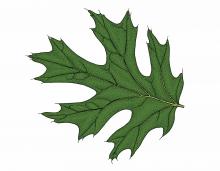Trees, Shrubs and Woody Vines
Media

Species Types
Scientific Name
Platanus occidentalis
Description
The white, smooth-looking limbs of sycamore rise over countless streams and river banks, as well as over sidewalks and city streets. The leaves, which somewhat resemble those of maples, can reach remarkably large sizes.
Media

Species Types
Scientific Name
Salix spp. (about 12 species in Missouri)
Description
Exotic willows are available at lawn and garden centers, but there are several willow species that are native to Missouri. Most are rather humble colonizers of gravel bars, riverbanks, and lakesides. Many are important for human economic interests. All have a place in our wild ecosystems.
Media

Species Types
Scientific Name
Quercus prinoides
Description
The dwarf chestnut oak, though only 3–10 feet tall and the shortest of Missouri's oaks, can nevertheless produce abundant acorns that are relished by several types of birds and mammals.
Media

Species Types
Scientific Name
Quercus velutina
Description
Black oak grows throughout Missouri, in upland woods, on glades, and along borders of woods and fields. It and scarlet oak were the primary colonizers of Ozark pinelands when the native pines were cleared in the early 1900s.
Media

Species Types
Scientific Name
Quercus shumardii
Description
Shumard oak is worth knowing: it can rise to 100 feet in height and gain a trunk diameter of 5 feet, with wide-spreading, muscular boughs.
Media

Species Types
Scientific Name
Quercus palustris
Description
Pin oak is one of the easiest trees to recognize by its shape alone: It has a tall, straight trunk, an overall pyramidal or conical shape and, most notably, the branches on the lower third of the tree angle downward.
Media

Species Types
Scientific Name
Quercus rubra
Description
Northern red oak is a favorite for planting in streets and parks and is one of the most widespread and commercially important of the oaks.
Media

Species Types
Scientific Name
Quercus spp.
Description
Oaks are the most important group of trees in Missouri, in both human and ecosystem value. They dominate most of the forests, woodlands, and savannas in the state. Learn more about our 22 species.
Media

Species Types
Scientific Name
Carya spp.
Description
Hickories are an important part of Missouri’s oak-hickory woodlands and forests. They have tremendous economic value, too. Learn about the nine species of hickory found in Missouri.
See Also
About Trees, Shrubs and Woody Vines in Missouri
There are no sharp dividing lines between trees, shrubs, and woody vines, or even between woody and nonwoody plants. “Wood” is a type of tissue made of cellulose and lignin that many plants develop as they mature — whether they are “woody” or not. Trees are woody plants over 13 feet tall with a single trunk. Shrubs are less than 13 feet tall, with multiple stems. Vines require support or else sprawl over the ground.





















